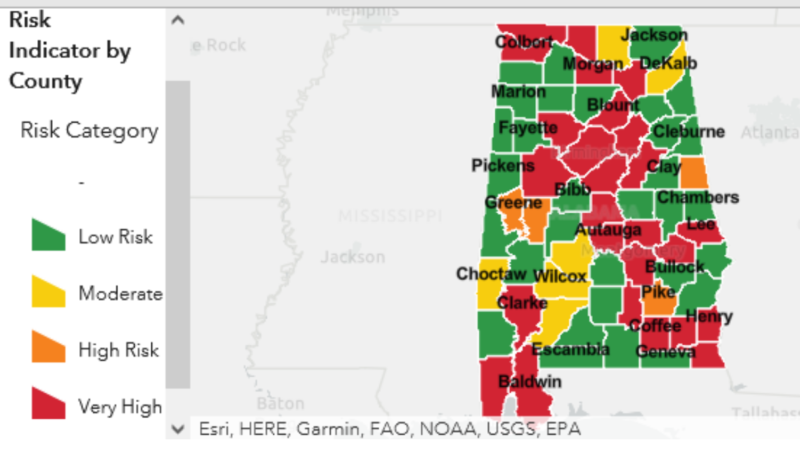Counties At Very High Risk Of COVID Spread Quadruples In 2 Weeks
The number of Alabama counties listed as being at “very high risk” for the spread of COVID-19 has quadrupled in the past two weeks, the state Department of Public Health reported Thursday.
ADPH listed six counties at ‘highest level of risk’ in its weekly report on June 24, but that total rose to 21 on July 1 and to 26 this week. The listings are based on statistics for the week ending the previous Saturday.
A county’s risk of COVID-19 spread is based on the number of new cases each day, calculated using the date of the onset of symptoms or the date a specimen was collected.
In addition to the counties listed as being at very high risk, four of the state’s 67 counties were listed as being at high risk, six at moderate risk and 31 at low risk.
The high-risk counties, spread across the state, are: Autauga, Baldwin, Blount, Chilton, Clarke, Coffee, Colbert, Crenshaw, Dale, Elmore, Henry, Houston, Jefferson, Lauderdale, Lee, Limestone, Macon, Marshall, Mobile, Montgomery, Morgan, St. Clair, Shelby, Talladega, Tuscaloosa and Walker.
Greene, Hale, Pike and Randolph counties were considered to be high risk.
Those shown as at moderate risk are Choctaw, Dallas, DeKalb, Madison, Monroe and Wilcox.
The number of new cases of the disease has grown statewide in recent weeks, reaching a total of 552,911 in Wednesday’s updated by ADPH. Alabama averaged 275 new cases a day over the past week, up from an average of 153 two weeks ago.
Russia sends 3 Iranian satellites into orbit, report says
The report said that a Russian rocket sent the satellites on Sunday from a launchpad in eastern Russia.
Viral global TikToks: A twist on soccer, Tanzania’s Charlie Chaplin, hope in Gaza
TikToks are everywhere (well, except countries like Australia and India, where they've been banned.) We talk to the creators of some of the year's most popular reels from the Global South.
This painting is missing. Do you have it?
An important work from a rediscovered artist has been absent from public view since the 1970s. A New York curator is hunting for it.
Memory loss: As AI gobbles up chips, prices for devices may rise
Demand for memory chips currently exceeds supply and there's very little chance of that changing any time soon. More chips for AI means less available for other products such as computers and phones and that could drive up those prices too.
Brigitte Bardot, sex goddess of cinema, has died
Legendary screen siren and animal rights activist Brigitte Bardot has died at age 91. The alluring former model starred in numerous movies, often playing the highly sexualized love interest.
For Ukrainians, a nuclear missile museum is a bitter reminder of what the country gave up
The Museum of Strategic Missile Forces tells the story of how Ukraine dismantled its nuclear weapons arsenal after independence in 1991. Today many Ukrainians believe that decision to give up nukes was a mistake.









